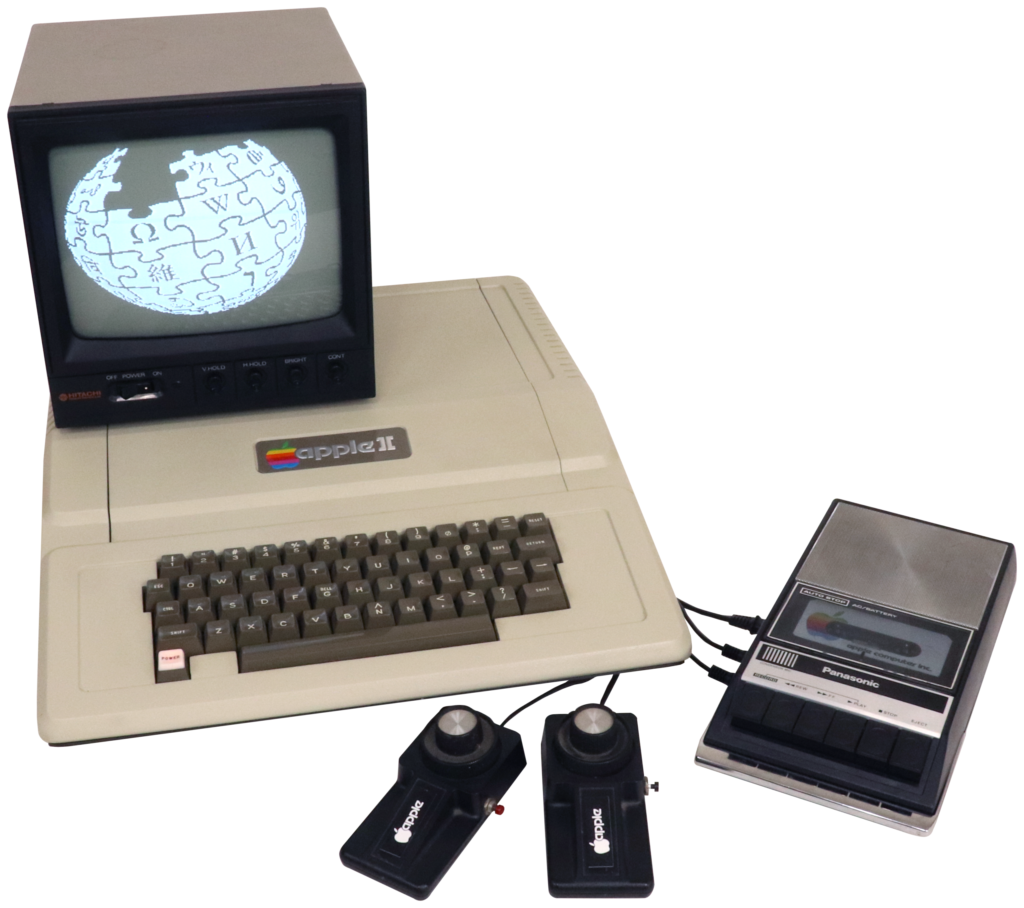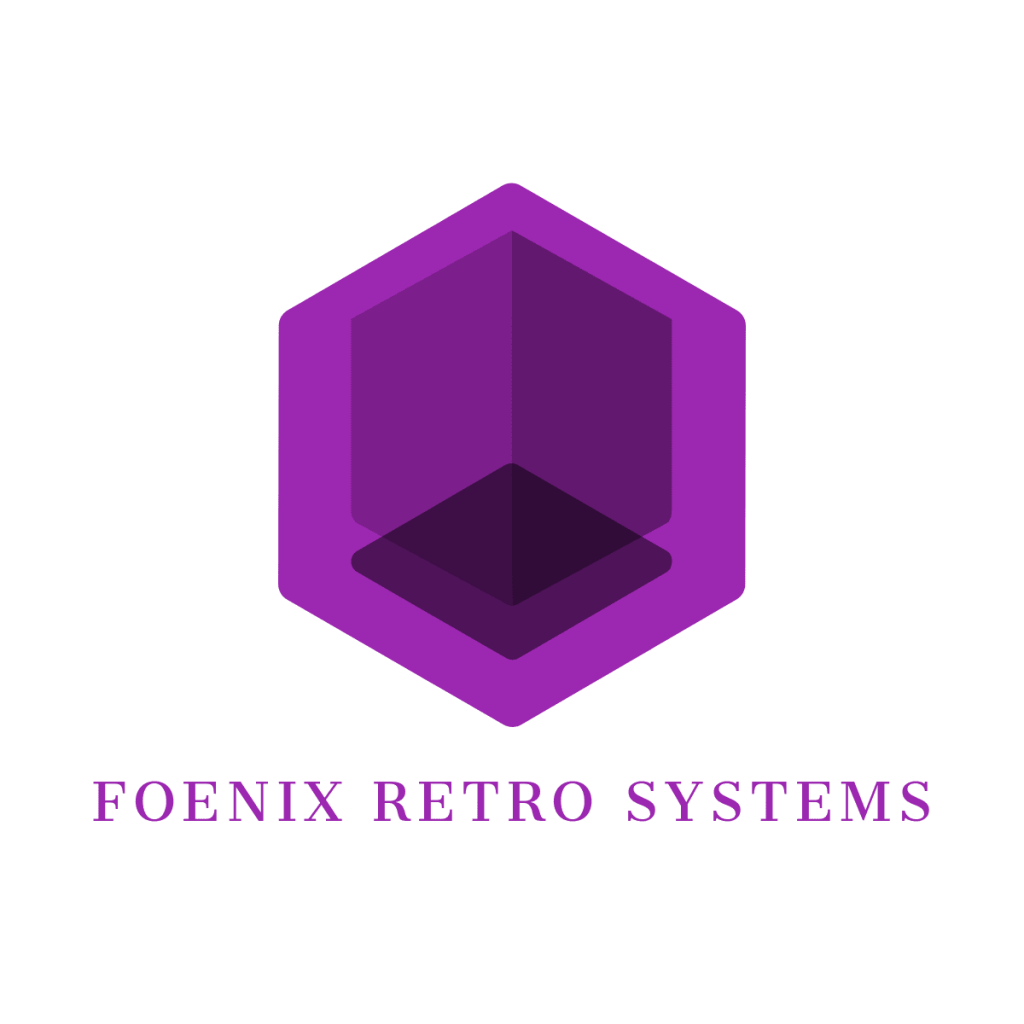Apple II (1977)
The venerable Apple II (nearing 45 years old) went on sale on June 10th in 1977. Bundled with a set of paddles and a cassette tape with demos (including a version of Breakout written in Steve Wozniak’s Integer Basic), Apple included a full set of manuals, some would argue, the best set of manuals to have been included with a new computer, ever. All the user needed was a composite monitor and optionally, a cassette player to load and save programs.
Wozniak and Jobs started several trends which were adopted by competitors and made their way into successor machines. One in particular kickstarted the personal computer peripheral industry before anybody knew what a “PC” was.

Original Apple II
This ‘typical configuration’ pictures an original Apple II with paddles, an add-on Hitachi monitor and a Panasonic cassette player/recorder
The Apple II had slots. Lots of slots. 8, to be precise. Each 50 pin slot offered an opportunity to interface with the outside world or to improve computing capabilities (memory expansion for example).
One of the most successful 3rd part adapter cards was an alternative operating system which leveraged a different (dissimilar) CPU; CP/M and its Zilog Z80 CPU became a popular Microsoft product before too many people knew who Microsoft was. It opened the door not only for a more performant (by clock speed) CPU, but a library of software titles for those fortunate enough to have purchased an Apple Floppy drive and controller.
The Apple Language Card was also very popular since it added 16K to bring the total to 64K which gave the computer the additional headroom required to develop in Pascal.

What’s wrong w/this picture? At least two things…
- The 6502 CPU is upside down (for this display); Originally, it was mounted ‘upside down’ relative to the rest of the text on the board as to permit most of the address lines to get up and out of the way before being routed at the ‘less busy’ end of the board. The KIM-1 did the same thing.
- The date code of this 6502 is 17th week of 1983 which is incorrect for an original Apple II.
At launch, there were precisely zero expansion cards on offer. But the most popular accessory did not occupy a slot at all, and was not an official Apple product. It was the Sup’R’Mod (included in the upper right of this display). Connected to a set of video output pins on the Apple II mother board, the Sup’R’Mod was an RF modulator that allowed the Apple to connect to a standard television.
Apple, after failing to gain FCC approval on their RF modular, arranged to have a local Silicon Valley based electronics firm named “M&R Enterprises” create the “peripheral” which could be affixed inside the Apple II case. Marty Spergel, who ran M&R was led to believe (by Steve Jobs) that he might sell as many as 50 units per month. Spergel later estimated that he sold about 400,000 units. At $29.95 each, this was quite a success story.
Other features, innovative at the time, included bitmapped graphics and color. In a day when the TRS-80 and Commodore Pet were both monochrome and offered only rudimentary low-res block or key graphics, this was a game changer, And of course, once serial adapters arrived on the scene, 3rd party companies began offering modems (such as this 300 baud Novation J-Cat you see here).
Byte magazine, Nibble, A+ and other publications quickly grew in subscribers and content, and built a marketplace of software and hardware add-ons. Prior to the Apple II release, this joy was only available to kit-builders and electronics buffs with access and know-how.
This display includes a reproduction of the Rev. 0 motherboard. At the bottom right, you’ll notice a ‘prototyping’ area; something Wozniak thought would be a good idea.
Other callouts include the white DIP ‘gaming’ socket, RCA type composite video output, and left/right cursor keys (but notably, no cursor up/down). Apple users would have to wait for the Apple IIe before getting dedicated keys for vertical cursor movement.
At launch, the Apple II sold for $1,298 USD; or about $5,543 in 2020 dollars.

Brought to you by Foenix Retro Systems
Did you know (?) the heart of the Apple IIGS, successor to the Apple IIe, was the same WDC 65C816 CPU leveraged in C256Foenix series machines including the FMX, the C256U+, and now is the main CPU of the new GEN X machines.
Fun fact: Apple famously restricted the IIGS clock to 2.8 MHz (versus the 14 MHz that Foenix systems run at) in order to protect the perception that the then-new 7.83 MHz Motorola 68000 based Macintosh was ‘fast’.
There are many great resources for Apple history, but this one: Apple II History is excellent, maybe the best.